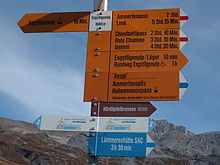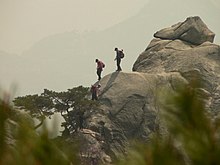Mountain hiking


The hiking is the hike on mountain trails in mountainous terrain . In contrast to mountaineering, when hiking in the mountains there is no need for a partner security; every hiker has to master the terrain on his own - even if he / she is climbing.
Types of mountain hiking tours
The routes for mountain hiking are roughly divided into valley hikes (yellow marked path ), mountain hikes (white-red-white marked path) and alpine hikes (white-blue-white marked path). If the valley hike is similar to normal hiking without major differences in altitude, apart from the typical mountain terrain, the mountain hike begins where the path is on the mountain slope. One speaks of alpine hike, very roughly, when there are mostly no tracks left. When it comes to alpine hikes, the mountain hiker is also called a mountaineer (to distinguish it from a mountaineer ) or an alpinist , the Alpine Route . Typically, from the valley hike to the alpine hike, the trails are poorly marked and developed or disappear entirely, the heights increase, glaciers, ice, scree fields and delicate meadow slopes are added and the route as a whole places increasing demands on experience, endurance, equipment and orientation skills . Mountain hiking becomes a tightrope walk when it takes place at a higher altitude without significant differences in altitude and the terrain slopes down on both sides. Despite the differentiation to mountaineering and climbing, many routes with a higher degree of difficulty also contain mountaineering and climbing passages , so that the transitions can be fluid. Contrary to popular belief, the more difficult alpine hiking trails already make higher demands than easy alpine tours .
Alpine accidents
In 2005 there was in Austria 416 killed in alpine accidents, the same year they lamented 764 deaths. In Tyrol there were 179 Alpine deaths and 57 road deaths. In relation to Austria, most fatal accidents occurred when hiking (130), followed climbing (36) Hochtour mountaineering (29). According to a Swiss study, there is one accident for every 7,143 hours of hiking. Seen in this way, only swimming is safer of popular recreational sports , while the risk of injury in winter sports exceeds that of hiking 7.5 times (18 times playing football). Fatal alpine accidents are caused by tripping, slipping and falling in 64%, exhaustion and overworking in 21%, the remaining 15% are distributed among disorientation, abandonment , stone and lightning strikes, heat or cold damage or avalanches .
Operator of alpine shelters
- German Alpine Club (DAV)
- Austrian Alpine Association (ÖAV)
- Swiss Alpine Club (SAC)
- Alpine Association South Tyrol (AVS)
- Friends of Nature Austria (NFÖ)
- NaturFreunde Germany (NFD)
literature
- Bernhard Rudolf Banzhaf: Dangers when hiking in the mountains . In: The Alps . No. 4 , 2005, p. 22-24 .
- Ueli Mosimann: Mountain hiking. Correct behavior in dangerous areas . In: The Alps . No. 4 , 2005, p. 24-27 .
- Martin Krauss : The porter was always there beforehand. The history of hiking and mountaineering in the Alps . Nagel & Kimche, Zurich 2013, ISBN 978-3-312-00558-1 .
Web links
- Roman Koch: A short introduction to mountain hiking (PDF; 171 kB)
- German Alpine Association: BergwanderCard
Individual evidence
- ↑ Adapted from “Alps deadlier than road traffic”, Medical Tribune, January 12, 2007, p. 12. Online (PDF; 869 kB) ( page no longer available , search in web archives ) Info: The link was automatically marked as defective. Please check the link according to the instructions and then remove this notice.

